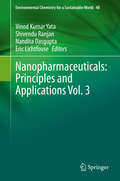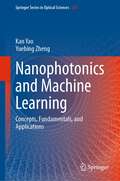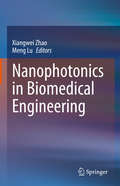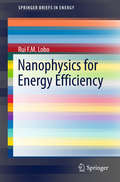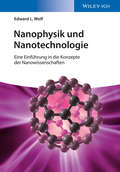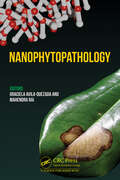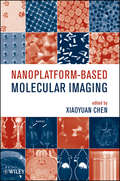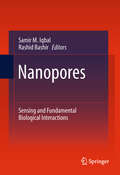- Table View
- List View
Nanopharmaceuticals: Principles and Applications Vol. 3 (Environmental Chemistry for a Sustainable World #48)
by Vinod Kumar Yata Shivendu Ranjan Nandita Dasgupta Eric LichtfouseThis book is the third volume on this subject and focuses on the recent advances of nanopharmaceuticals in cancer, dental, dermal and drug delivery applications and presents their safety, toxicity and therapeutic efficacy. The book also includes the transport phenomenon of nanomaterials and important pathways for drug delivery applications. It goes on to explain the toxicity of nanoparticles to different physiological systems and methods used to assess this for different organ systems using examples of in vivo systems.
Nanophenomena at Surfaces
by Michail MichailovThis book presents the state of the art in nanoscale surface physics. It outlines contemporary trends in the field covering a wide range of topical areas: atomic structure of surfaces and interfaces, molecular films and polymer adsorption, biologically inspired nanophysics, surface design and pattern formation, and computer modeling of interfacial phenomena. Bridging "classical" and "nano" concepts, the present volume brings attention to the physical background of exotic condensed-matter properties. The book is devoted to Iwan Stranski and Rostislaw Kaischew, remarkable scientists, who played a crucial role in setting up the theoretical fundamentals of nucleation and crystal growth phenomena in the last century.
Nanophotocatalysis and Environmental Applications: Detoxification and Disinfection (Environmental Chemistry for a Sustainable World #30)
by Inamuddin Abdullah M. Asiri Eric LichtfouseThis book will be a guiding path to understand the photocatalytic process and mechanism for the deterioration of heavy metals, persistent organic pollutants and pathogens from wastewater. Environmental remediation is of crucial importance in the context of human sustainability in the present and future times. The unplanned anthropogenic activities and revolutionary industrialization end up in environmental contamination with noxious organic-inorganic and biogenic pollutants. The photocatalytic disinfection and detoxification is the only solution to preserve and restore the ecological balance. The main emphasis is to explore and enhance the photocatalytic potentials of solar active-materials.
Nanophotonic Chemical Reactions: New Photochemical Reactions and Their Applications (Nano-Optics and Nanophotonics)
by Takashi YatsuiThis book introduces readers to the cutting-edge topic of nanophotonic photochemical reactions and their applications. From among the various innovations in optical technology achieved by means of the non-uniform optical near field, it focuses on photochemical reactions at the nanoscale. Optical near fields are the elementary surface excitations of nanometric particles with non-uniform field distributions. After reviewing the unique properties of the non-uniform optical field, the book presents a range of applications of near-field assisted photochemical reactions, including near-field etching, visible water splitting, carbon dioxide reduction and reactions in solar cells.
Nanophotonic Information Physics
by Makoto NaruseThis book provides a new direction in the field of nano-optics and nanophotonics from information and computing-related sciences and technology. Entitled by "Information Physics and Computing in NanosScale Photonics and Materials", IPCN in short, the book aims to bring together recent progresses in the intersection of nano-scale photonics, information, and enabling technologies. The topic will include (1) an overview of information physics in nanophotonics, (2) DNA self-assembled nanophotonic systems, (3) Functional molecular sensing, (4) Smart fold computing, an architecture for nanophotonics, (5) semiconductor nanowire and its photonic applications, (6) single photoelectron manipulation in imaging sensors, (6) hierarchical nanophotonic systems, (8) photonic neuromorphic computing, and (9) SAT solver and decision making based on nanophotonics.
Nanophotonics (Springer Series In Optical Sciences #213)
by Arthur McGurnThis book gives a readable introduction to the important, rapidly developing, field of nanophotonics. It provides a quick understanding of the basic elements of the field, allowing students and newcomers to progress rapidly to the frontiers of their interests. Topics include: The basic mathematical techniques needed for the study of the materials of nanophotonic technology; photonic crystals and their applications as laser resonators, waveguides, and circuits of waveguides; the application of photonic crystals technology in the design of optical diodes and transistors; the basic properties needed for the design and understanding of new types of engineered materials known as metamaterials; and a consideration of how and why these engineered materials have been formulated in the lab, as well as their applications as negative refractive index materials, as perfect lens, as cloaking devices, and their effects on Cherenkov and other types of radiation. Additionally, the book introduces the new field of plasmonics and reviews its important features. The role of plasmon-polaritons in the scattering and transmission of light by rough surfaces and the enhanced transmission of light by plasmon-polariton supporting surfaces is addressed. The important problems of subwavelength resolution are treated with discussions of applications in a number of scientific fields. The basic principles of near-field optical microscopy are presented with a number of important applications. The basics of atomic cavity physics, photonic entanglement and its relation to some of the basic properties of quantum computing, and the physics associated with the study of optical lattices are presented.
Nanophotonics and Machine Learning: Concepts, Fundamentals, and Applications (Springer Series in Optical Sciences #241)
by Kan Yao Yuebing ZhengThis book, the first of its kind, bridges the gap between the increasingly interlinked fields of nanophotonics and artificial intelligence (AI). While artificial intelligence techniques, machine learning in particular, have revolutionized many different areas of scientific research, nanophotonics holds a special position as it simultaneously benefits from AI-assisted device design whilst providing novel computing platforms for AI. This book is aimed at both researchers in nanophotonics who want to utilize AI techniques and researchers in the computing community in search of new photonics-based hardware. The book guides the reader through the general concepts and specific topics of relevance from both nanophotonics and AI, including optical antennas, metamaterials, metasurfaces, and other photonic devices on the one hand, and different machine learning paradigms and deep learning algorithms on the other. It goes on to comprehensively survey inverse techniques for device design, AI-enabled applications in nanophotonics, and nanophotonic platforms for AI. This book will be essential reading for graduate students, academic researchers, and industry professionals from either side of this fast-developing, interdisciplinary field.
Nanophotonics and Plasmonics: An Integrated View (Series in Optics and Optoelectronics)
by Dr Ching Png Dr Yuriy AkimovThis book provides a first integrated view of nanophotonics and plasmonics, covering the use of dielectric, semiconductor, and metal nanostructures to manipulate light at the nanometer scale. The presentation highlights similarities and advantages, and shows the common underlying physics, targets, and methodologies used for different materials (optically transparent materials for nanophotonics, vs opaque materials for plasmonics). Ultimately, the goal is to provide a basis for developing a unified platform for both fields. In addition to the fundamentals and detailed theoretical background, the book showcases the main device applications. <P><P> Ching Eng (Jason) Png is Director of the Electronics and Photonics Department at the Institute of High Performance Computing, Agency for Science Technology and Research, Singapore. <P><P> Yuriy A. Akimov is a scientist in the Electronics and Photonics Department at the Institute of High Performance Computing, Agency for Science Technology and Research, Singapore.
Nanophotonics in Biomedical Engineering
by Xiangwei Zhao Meng LuThis book summarizes the latest advances in nanophotonics for biomedical applications, including biomolecular sensing and imaging, additive fabrications, and biophotonics. The engineering of nanophotonics will have significant impacts on the life sciences and medicine alike. Given its scope, the book offers a valuable asset for researchers, scientists, engineers, and graduate students in the fields of biomedical engineering, electrical engineering, materials sciences, optics, biology, and medicine.
Nanophotonics, Nanooptics, Nanobiotechnology, and Their Applications: Selected Proceedings of the 6th International Conference Nanotechnology and Nanomaterials (NANO2018), August 27-30, 2018, Kyiv, Ukraine (Springer Proceedings in Physics #222)
by Olena Fesenko Leonid YatsenkoThis book highlights some of the latest advances in nanotechnology and nanomaterials from leading researchers in Ukraine, Europe, and beyond. It features contributions from participants in the 6th International Science and Practice Conference Nanotechnology and Nanomaterials (NANO2018) in Kiev, Ukraine on August 27-30, 2018 organized by the Institute of Physics of the National Academy of Sciences of Ukraine, University of Tartu (Estonia), University of Turin (Italy), and Pierre and Marie Curie University (France). Internationally recognized experts from a wide range of universities and research institutions share their knowledge and key results on nanooptics, energy storage and biomedical applications. This book's companion volume also addresses topics such as materials properties, behavior, and synthesis.
Nanophysics and Nanotechnology: An Introduction to Modern Concepts in Nanoscience
by Edward L. WolfLong awaited new edition of this highly successful textbook, provides once more a unique introduction to the concepts, techniques and applications of nanoscale systems by covering its entire spectrum up to recent findings on graphene.
Nanophysics for Energy Efficiency
by Rui F. M. LoboThis book provides a succinct account of the ways in which nano technology is being applied to improve energy efficiency. The coverage includes current scanning probe techniques for electrical energy storage, energy harvesting systems and local electrochemistry as well as emerging techniques of relevance to diverse materials and devices, including advanced scanning probes for nano fabrication and nano tribology. The tools of nanotechnology, such as scanning probe microscopes and micro machines, can provide important information about the fundamental nature of space, especially the zero-point electromagnetic field. An exciting aspect of this subject is that a better understanding of the force that arises from the zero-point field, i. e. , the Casimir force, may enable its control to some extent, impacting on the development of nano electromechanical systems. Readers will find this book to be a clear and concise summary of the state of the art in nanophysics and nanotechnology as they relate to energy efficiency.
Nanophysics, Nanomaterials, Interface Studies, and Applications
by Olena Fesenko Leonid YatsenkoThis book presents some of the latest achievements in nanotechnology and nanomaterials from leading researchers in Ukraine, Europe, and beyond. It features selected peer-reviewed contributions from participants in the 4th International Science and Practice Conference Nanotechnology and Nanomaterials (NANO2016) held in Lviv, Ukraine on August 24-27, 2016. The International Conference was organized jointly by the Institute of Physics of the National Academy of Sciences of Ukraine, Ivan Franko National University of Lviv (Ukraine), University of Tartu (Estonia), University of Turin (Italy), and Pierre and Marie Curie University (France). Internationally recognized experts from a wide range of universities and research institutions share their knowledge and key results on topics ranging from nanooptics, nanoplasmonics, and interface studies to energy storage and biomedical applications.
Nanophysics, Nanophotonics, Surface Studies, and Applications
by Olena Fesenko Leonid YatsenkoThis book presents some of the latest achievements in nanotechnology and nanomaterials from leading researchers in Ukraine, Europe, and beyond. It features contributions from participants in the 3rd International Science and Practice Conference Nanotechnology and Nanomaterials (NANO2015) held in Lviv, Ukraine on August 26-30, 2015. The International Conference was organized jointly by the Institute of Physics of the National Academy of Sciences of Ukraine, University of Tartu (Estonia), Ivan Franko National University of Lviv (Ukraine), University of Turin (Italy), Pierre and Marie Curie University (France), and European Profiles A. E. (Greece). Internationally recognized experts from a wide range of universities and research institutions share their knowledge and key results on topics ranging from nanooptics, nanoplasmonics, and interface studies to energy storage and biomedical applications.
Nanophysics of Solar and Renewable Energy
by Edward L. WolfThis easy accessible textbook provides an overview of solar to electric energy conversion, followed by a detailed look at one aspect, namely photovoltaics, including the underlying principles and fabrication methods. Ed Wolf, an experienced author and teacher, reviews such green technologies as solar-heated-steam power, hydrogen, and thermoelectric generation, as well as nuclear fusion. Throughout the book, carefully chosen, up-to-date examples are used to illustrate important concepts and research tools. The opening chapters give a broad and exhaustive survey of long term energy resources, reviewing current and potential types of solar driven energy sources. The core part of the text on solar energy conversion discusses different concepts for generating electric power, followed by a profound presentation of the underlying semiconductor physics and rounded off by a look at efficiency and third-generation concepts. The concluding section offers a rough analysis of the economics relevant to the large-scale adoption of photovoltaic conversion with a discussion of such issues as durability, manufacturability and cost, as well as the importance of storage. The book is self-contained so as to be suitable for students with introductory calculus-based courses in physics, chemistry, or engineering. It introduces concepts in quantum mechanics, atomic and molecular physics, plus the solid state and semiconductor junction physics needed to attain a quantitative understanding of the current status of this field. With its comments on economic aspects, it is also a useful tool for those readers interested in a career in alternative energy.
Nanophysik und Nanotechnologie
by Edward L. WolfNoch hat das Motto "Alles muss kleiner werden" nicht an Faszination verloren. Physikern, Ingenieuren und Medizinern erschließt sich mit der Nanotechnologie eine neue Welt mit faszinierenden Anwendungen. E. L. Wolf, Physik-Professor in Brooklyn, N. Y. , schrieb das erste einführende Lehrbuch zu diesem Thema, in dem er die physikalischen Grundlagen ebenso wie die Anwendungsmöglichkeiten der Nanotechnologie diskutiert. Mittlerweile ist es in der 3. Auflage erschienen und liegt jetzt endlich auch auf Deutsch vor. Dieses Lehrbuch bietet eine einzigartige, in sich geschlossene Einführung in die physikalischen Grundlagen und Konzepte der Nanowissenschaften sowie Anwendungen von Nanosystemen. Das Themenspektrum reicht von Nanosystemen über Quanteneffekte und sich selbst organisierende Strukturen bis hin zu Rastersondenmethoden. Besonders die Vorstellung von Nanomaschinen für medizinische Anwendungen ist faszinierend, wenn auch bislang noch nicht praktisch umgesetzt. Der dritten Auflage, auf der diese Übersetzung beruht, wurde ein neuer Abschnitt über Graphen zugefügt. Die Diskussion möglicher Anwendungen in der Energietechnik, Nanoelektronik und Medizin wurde auf neuesten Stand gebracht und wieder aktuelle Beispiele herangezogen, um wichtige Konzepte und Forschungsinstrumente zu illustrieren. Der Autor führt mit diesem Lehrbuch Studenten der Physik, Chemie sowie Ingenieurwissenschaften von den Grundlagen bis auf den Stand der aktuellen Forschung. Die leicht zu lesende Einführung in dieses faszinierende Forschungsgebie ist geeignet für fortgeschrittene Bachelor- und Masterstudenten mit Vorkenntnissen in Physik und Chemie. "Zusammenfassend ist festzustellen, dass Edward L. Wolf trotz der reichlich vorhandenen Literatur zur Nanotechnologie ein individuell gestaltetes einführendes Lehrbuch gelungen ist. Es eignet sich - nicht zuletzt dank der enthaltenen Übungsaufgaben - bestens zur Vorlesungsbegleitung für Studierende der Natur- und Ingenieurwissenschaften sowie auch spezieller nanotechnologisch orientierter Studiengänge. " Physik Journal ". . . eine sehr kompakte, lesenswerte und gut verständliche Einführung in die Quantenmechanik sowie ihre Auswirkungen auf die Materialwissenschaften. . . " Chemie Ingenieur Technik
Nanophytopathology
by Graciela Avila-Quezada Mahendra RaiThe book entitled ‘Nanophytopathology’ discusses the need for alternative technologies particularly smart nanotechnological tools including nanobiosensor in the detection of plant diseases, delivery of fungicides/pesticides, and therapy for the diseases caused by plant pathogens and pests. The use of nanomaterials will minimize the huge amount of application of pesticides and fungicides thereby reducing environmental pollution. This technology is eco-friendly, economically viable, and useful for sustainable crop production. The book encompasses chapters written by experienced experts in respective fields, which provide up-to-date knowledge about pathogen/pest control using nanotechnology. It will be essential reading for post-graduate students and researchers, agriculture scientists, nanotechnologists, microbiologists, green chemistry experts, and biotechnologists.
Nanoplasmonic Sensors
by Alexandre DmitrievThis book is a compendium of the finest research in nanoplasmonic sensing done around the world in the last decade. It describes basic theoretical considerations of nanoplasmons in the dielectric environment, gives examples of the multitude of applications of nanoplasmonics in biomedical and chemical sensing, and provides an overview of future trends in optical and non-optical nanoplasmonic sensing. Specifically, readers are guided through both the fundamentals and the latest research in the two major fields nanoplasmonic sensing is applied to - bio- and chemo-sensing - then given the state-of-the-art recipes used in nanoplasmonic sensing research.
Nanoplasmonics: Advanced Device Applications (Devices, Circuits, and Systems)
by James W. M. Chon Krzysztof IniewskiFocusing on control and manipulation of plasmons at nanometer dimensions, nanoplasmonics combines the strength of electronics and photonics, and is predicted to replace existing integrated circuits and photonic devices. It is one of the fastest growing fields of science, with applications in telecommunication, consumer electronics, data storage, medical diagnostics, and energy. Nanoplasmonics: Advanced Device Applications provides a scientific and technological background of a particular nanoplasmonic application and outlines the progress and challenges of the application. It reviews the latest developments in nanoplasmonic applications, such as optical storage, photovoltaics, photocatalysts, integrated chips, optical elements, and sensing. The areas of application were chosen for their practicality, and each chapter provides a balanced scientific review and technological progress of how these areas of application are shaping the future.
Nanoplasmonics, Nano-Optics, Nanocomposites, and Surface Studies
by Olena Fesenko Leonid YatsenkoThis book highlights the most recent advances in nano science from leading researchers in Ukraine, Europe and beyond. It features contributions from participants of the 3rd International Summer School "Nanotechnology: From Fundamental Research to Innovations," held in Yaremche, Ukraine on August 23-26, 2014 and of the 2nd International NANO-2014 Conference, held in Lviv, Ukraine on August 27-30, 2014. These events took place within the framework of the European Commission FP7 project Nano twinning and were organized jointly by the Institute of Physics of the National Academy of Sciences of Ukraine, University of Tartu (Estonia), University of Turin (Italy) and Pierre and Marie Curie University (France). Internationally recognized experts from a wide range of universities and research institutions share their knowledge and key results in the areas of nanocomposites and nanomaterials, nanostructured surfaces, microscopy of nano-objects, nano-optics and nano photonics, nano plasmonics, nano chemistry, nano biotechnology and surface enhanced spectroscopy. Covers nanocomposites, nano structured surfaces and nano biotechnology Presents state-of-the-art advances in nano plasmonics, nanomaterials characterization and surface enhanced spectroscopy Represents essential reading for advanced undergraduate and graduate students through practicing university and industry researchers
Nanoplatform-Based Molecular Imaging
by Xiaoyuan ChenThe cutting-edge guide on advancing the science of molecular imaging using nanoparticlesNanoplathform-Based Molecular Imaging provides rationale for using nanoparticle-based probes for molecular imaging, then discusses general strategies for this underutilized, yet promising, technology. It addresses general strategies of particle synthesis and surface chemistry, applications in computed tomography optical imaging, magnetic resonance imaging, ultrasound, multimodality imaging, theranostics, and finally, the clinical perspectives of nanoimaging. This comprehensive volume summarizes the opinions of those in the forefront of research and describes the latest developments by emphasizing fundamentals and initiating hands-on application.
Nanopore-Based Technology
by Maria E. GrachevaNanopores are vital biological features, described as tiny holes in cellular membranes used for recognition and transport of ions and molecules between compartments within the cell, as well as between the extracellular environment and the cell itself. Their study, ever growing in esteem, leads toward the promise of ultra-fast sequencing of DNA molecules with the ultimate goal of building a nanoscale device that will make rapid and cheap DNA sequencing a reality. In Nanopore-Based Technology, expert researchers in the forefront of the field explore the cutting-edge of nanopore technology for single molecule sensing, detection, and characterization. Divided into four convenient parts, this volume covers single molecule characterization techniques utilizing biological pores, methods for biomolecule characterization with nanoporous artificial membranes, computational studies of the biomolecule confined within the nanopore environment, as well as techniques that use novel materials in conjunction with nanopore sensing. Written for the highly successful Methods in Molecular BiologyTM series, this work provides the kind of detailed description and implementation advice that is crucial for achieving optimal results. Authoritative and state-of-the-art, Nanopore-Based Technology serves as an excellent representation of the present-day available techniques for biomolecule characterization with nanoporous membranes in order to guide researchers toward developing the next generation of technologies for fast and cheap DNA sequencing with practically no limitations on the read lengths.
Nanopores
by Rashid Bashir Samir M. IqbalNanopores are nanometer scale holes formed naturally by proteins or cells, and can be used for a variety of applications, including sequencing DNA and detecting anthrax. They can be integrated into artificially constructed encapsulated cells of silicon wafers while allowing small molecules like oxygen, glucose and insulin to pass, while keeping out large system molecules. "Nanopores: Sensing and Fundamental Biological Interactions" examines the emerging research directions surrounding nanopores such as genome sequencing and early disease detection using biomarker identification. Covering the applications of nanopores in genetics, proteomics, drug discovery, early disease detection and detection of emerging environmental threats, it is a must-have book for biomedicalengineers and research scientists.
Nanoporous Alumina
by Dusan Losic Abel SantosThis book gives detailed information about the fabrication, properties and applications of nanoporous alumina. Nanoporous anodic alumina prepared by low-cost, simple and scalable electrochemical anodization process due to its unique structure and properties have attracted several thousand publications across many disciplines including nanotechnology, materials science, engineering, optics, electronics and medicine. The book incorporates several themes starting from the understanding fundamental principles of the formation nanopores and theoretical models of the pore growth. The book then focuses on describing soft and hard modification techniques for surface and structural modification of pore structures to tailor specific sensing, transport and optical properties of nano porous alumina required for diverse applications. These broad applications including optical biosensing, electrochemical DNA biosensing, molecular separation, optofluidics and drug delivery are reviewed in separated book chapters. The book appeals to researchers, industry professionals and high-level students.
Nanoporous Carbons for Soft and Flexible Energy Devices (Carbon Materials: Chemistry and Physics #11)
by Francesca Borghi Francesca Soavi Paolo MilaniThis book provides an interesting snapshot of new research within the fields of flexible and soft devices which use porous carbon-based materials. The increase in demand for soft and flexible electronics, electrochemical energy storage/conversion systems, piezoresistive pressure sensors has promoted the development of new strategies for the synthesis and integration of nanoporous carbon (NPC) into flexible and soft polymers and inorganic textures. The structural properties of such NPC materials combined with their mechanical, conductive and catalytic properties, show promising results for the technology they are designed for, which can be useful solutions in many other disciplines. An in-depth discussion of the use of NPC materials in different energy devices is provided in every chapter, while at the same time the knowledge of the reader on the various applications where these materials can be used will be broadened. This book sheds new light on nanoporous carbon-based materials and will be of great interest to graduate students and professionals working in this field.
